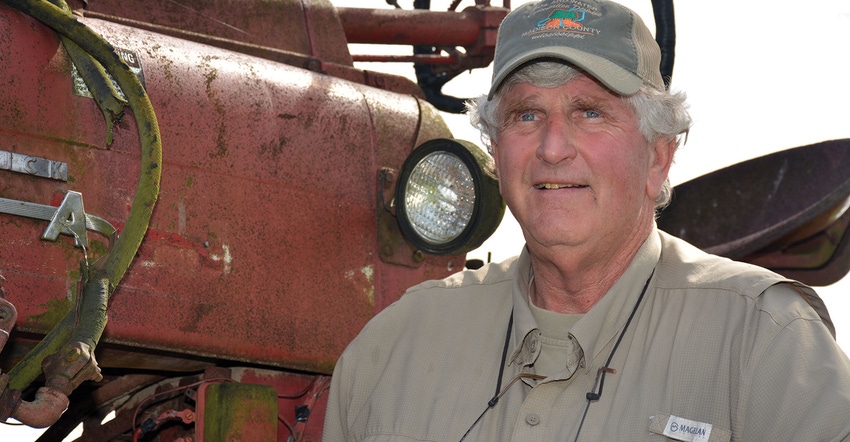
Changing weather means farmers must make new decisions as they assess their land during planting season.
Pete Hunter, near Clarksdale, Miss., might be semi-retired, but he still stays busy on the farm helping Bo and Mark Crumpton as well as John McKee between whom his farmland is split.
"I retired from active farming in 2015, but I couldn't stay in retirement," Hunter said. "Retiring has given me time to slow down a little bit. It is a process. When I retired, Stovall Farms was split and rented out between two farming families. John McKee farms about half the farm along with his farming operation, and Mark and Bo Crumpton farm the other half along with their other farming operation."
Half the week Hunter helps McKee on his farm, and the other half, he helps the Crumptons.
"The nice thing is I get to do things I haven't been able to do much since I was a kid, like drive tractors and sprayers, and I also help the farmers in making decisions and managing the land," he said. "I do conservation projects, too. I'm deep-rooted in conservation; we do things like NRCS projects on the farms."
Farm plans
"On John McKee's whole operation, not just Stovall Farms, we were planting about 800 to 900 acres of corn. Because of weather conditions, he has had seep water on his farm, Five Point Farm," Hunter said. "The seep water from the river has been bad for three years in a row, and some of the corn was not able to be planted because of the wet conditions since we weren't able to get enough land prepared. I'm happy to say the seep water appears to be receding, and some of the land is starting to dry out."
Their corn acreage is down 500 acres.
"John has booked some corn at a decent price, so, of course, he wanted to get it all planted," he said. "We did plant some cotton on John's farm the first week of May, but it was on heavy land, so we increased the seeding rate.
"With Mark and Bo Crumpton's farm, they had intentions of planting corn for rotation, but prices kept dropping, so we did not plant any corn on their operation. Instead, we are going to plant cotton and some more soybeans."
On the Crumptons' farm, they started planting cotton the last week of April.
"We suspended planting cotton for a time because of cool temperatures and rainy weather," Hunter said. "Everything is changing on a day to day basis because of the weather this year. There's a new decision made on planting almost every day."
COVID-19 affecting the farm
Hunter said COVID-19 has made them all more cautious.
"I'm personally more at risk, so I try to stay away from town and places with a lot of people as much as possible, and I wear a mask and gloves if I do go out," he said. "We are also trying to keep our employees aware of the fact that this is a serious situation, and they need to take precautions, too. If we got COVID-19 in our labor force, it could shut us down."
The economy and market prices are another concern.
"I think the markets will recover; it's just a question of when that will be," Hunter said. "Corn is down in the low threes. I have no interest in corn other than for a rotation, but who wants to do a rotation at a loss? With soybeans, I'm concerned right now about the optimum time to plant them. In my opinion, the time to plant them is extremely late March and early April. We've got most of our soybeans planted, but we are into May now, which means the yield possibilities are down because of the later-planted crop."
They still have a few fields that were muddy and too wet to plant, so some soybeans may be planted even later.
"We feel like cotton probably has the best profit potential of all the crops," he said. "Somebody else may not think so, but we feel that way. I'm optimistic about cotton. I think with the government support, and our yield potential on cotton, it is the blue-sky crop right now. Overall, on the farms, we did sell some soybeans at the $9 price range, and the land produces good soybeans, so we should make a little money from them. We did not adjust the cotton down because of low prices, but we did adjust the corn down because of prices."
Conservation: An important practice
As the past state president of the Mississippi Association of Conservation Districts and chairman of Mississippi Soil Water Conservation Commission, Hunter believes strongly in conservation and preserving the land.
"One of our big projects right now is called the Carter Rocky Bayou Levee system. Farmland in the Yazoo City area has had flooding from the Yazoo River, so we have a project to help with the flooding in those areas," he said.
On Stovall Farms, Hunter has a conservation plan, which is modified every year to address any new problems.
"One big project we have on the Crumpton's land is they have about 900 acres behind the levee that is often flooded by the river," Hunter said. "We got a conservation easement, a WRE, put in for all the land. The land has been accepted and will have trees planted instead of crops. It's good farmland, but you can expect a good crop maybe two out of five years.
"The husbandry of the land should be a top priority in farming."
About the Author(s)
You May Also Like




